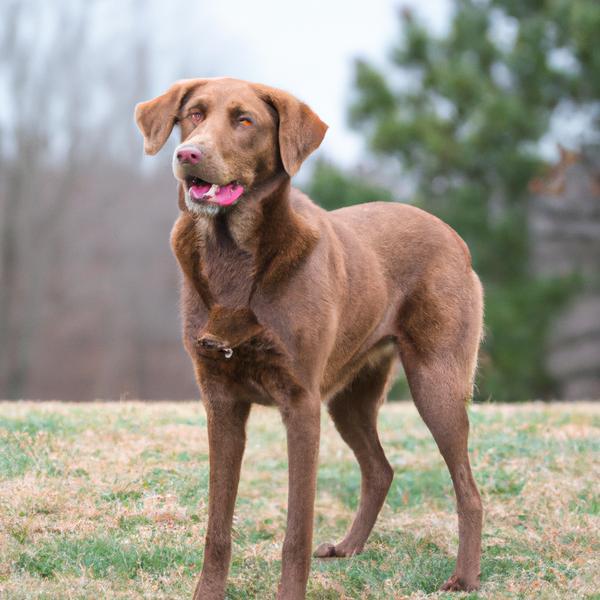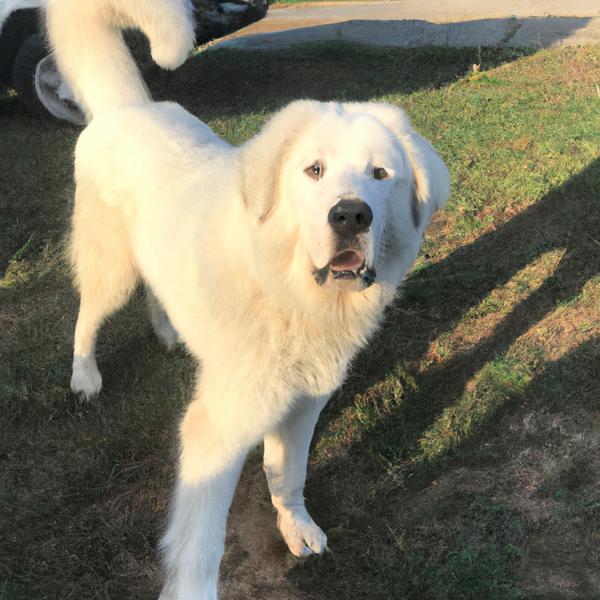
Chesapeake Bay Retriever Breed Information & Characteristics
Weight Gain Potential
Do Chesapeake Bay Retrievers get fat easily?
The Chesapeake Bay Retriever is a breed that has an average to high tendency to gain weight if their weight is not closely monitored. It is important to maintain a balance between exercise and food intake to keep them at a healthy weight. This can be achieved by scheduling at least one daily walk and engaging in regular playtime with them.
Hypoallergenic
Are Chesapeake Bay Retrievers Hypoallergenic?
Unfortunately, the Chesapeake Bay Retriever is not hypoallergenic, making it not a good choice for a dog lover who suffers from pet allergies.
Temperament
What is a Chesapeake Bay Retriever personality? What are Chesapeake Bay Retriever dogs best known for?
Happy
Dominant
Protective
Affectionate
Intelligent
Quiet
Shedding Level
Are Chesapeake Bay Retrievers heavy shedders? How Much Does a Chesapeake Bay Retriever Shed?
Chesapeake Bay Retriever dogs are not heavy shedders, but they will lose a significant amount of hair each year. To decrease the amount of shedding, you can regularly brush your Chesapeake Bay Retriever. This will remove loose hair and keep his coat growing in the same direction.
Watchdog Ability
What is the watchdog ability of a Chesapeake Bay Retriever dog?
The Chesapeake Bay Retriever dogs are average watchdogs. If they sense something different, this breed will alert their owner.
Origin
Where do Chesapeake Bay Retrievers come from?
United States
Ancestry
What are Chesapeake Bay Retrievers descended from?
Newfoundland dog
Breed recognition
What organizations or kennel clubs recognize/register the Chesapeake Bay Retriever breed?
American Canine Registry
American Kennel Club
America's Pet Registry
Canadian Kennel Club
Dog Registry of America Inc.
Federation Cynologique Internationale
Kennel Club of Great Britain
North American Purebred Registry, Inc.
American Canine Association, Inc.
Australian National Kennel Council
Continental Kennel Club
National Kennel Club
New Zealand Kennel Club
United Kennel Club
Date of Birth
When were Chesapeake Bay Retrievers first bred? How old is the Chesapeake Bay Retriever breed?
1800s
Breed Group
What Breed Group is a Chesapeake Bay Retriever?
Sporting (AKC:1878)
Gundog (UKC)
Eye Color Possibilites
What color are Chesapeake Bay Retriever eyes?
Brown
Amber
Nose Color Possibilites
What color can Chesapeake Bay Retriever nose be naturally?
Brown
Coat Color Possibilites
What color can Chesapeake Bay Retriever coat be naturally?
Brown
Red
Coat Length
How long is a Chesapeake Bay Retrievers coat?
The coat of a Chesapeake Bay Retriever dog ranges in length from short to medium.
Coat Density
How Dense Is The Chesapeake Bay Retriever Coat?
Coat Texture
What is the texture of the hair of a Chesapeake Bay Retriever?
Wavy
Litter Size
How many puppies can a Chesapeake Bay Retriever have in a litter? How many puppies can a Chesapeake Bay Retriever have in her first litter?
A Chesapeake Bay Retriever can have a litter of 10-13 puppies on average. However, it's worth noting that the size of the litters can vary greatly. Factors that can influence litter size include the health of the mother, breeding history, and genetics.
Adaptability
Chesapeake Bay Retriever dogs generally adapt well to changes in lifestyle and different living environments, but it is considered as an average level of adaptability compared to other breeds.
Health Issues
Do Chesapeake Bay Retrievers have a lot of health problems?
The Chesapeake Bay Retriever is generally considered to be healthy. However, like all breeds, they are susceptible to certain health issues and it is important to keep an eye out for them and address them with your veterinarian as needed.
Major Concerns
What are the major health concerns to be aware of when owning a Chesapeake Bay Retriever?
Hip Dysplasia
Minor Concerns
What are the less significant issues to keep in mind when it comes to Chesapeake Bay Retrievers?
Progressive Retinal Atrophy
Cataracts
Occasional Tests
What are the occasional tests recommended for Chesapeake Bay Retriever breed?
Eye
Hip
Blood
Dna For Vwd
Physical Examination
Energy
Do Chesapeake Bay Retrievers have a lot of energy?
Chesapeake Bay Retrievers are high-energy dogs, thus an active lifestyle suits them well.
Social Needs
Do Chesapeake Bay Retrievers need socialization? How social are Chesapeake Bay Retrievers?
Chesapeake Bay Retrievers have average social needs compared to other breeds. They are known to be less active and independent than other breeds, and they are content with spending time alone and with their human family.
Exercise Needed
How much exercise should Chesapeake Bay Retrievers get?
The Chesapeake Bay Retriever needs a high level of physical activity to maintain a healthy lifestyle. They also make great companions for people who lead an active lifestyle and enjoy running, hiking or other outdoor activities. These breeds are not suitable for people with sedentary lifestyle or those who live in small apartments
Sleeping Need
How much sleep should a Chesapeake Bay Retriever have? Do Chesapeake Bay Retrievers sleep a lot?
Chesapeake Bay Retrievers are active dogs that don't require as much sleep as other breeds. However, they still need enough sleep to stay healthy.
Drooling Tendency
Does a Chesapeake Bay Retriever drool a lot?
The Chesapeake Bay Retriever is known to be an average drooler among dog breeds. Drooling is the unintentional flow of saliva outside of the mouth and can be a normal characteristic of certain breeds or it can be a sign of a health problem. In the case of the Chesapeake Bay Retriever, it is a normal part of their physiology, however it is important to keep an eye on the amount of drooling and any changes in drooling patterns, as excessive drooling can be an indication of an underlying health issue and should be checked by a veterinarian.
Tendency to Bark
How much does it bark?
Chesapeake Bay Retrievers tend to bark moderately, they bark when necessary, such as to alert their owner or to communicate something. They may also bark due to certain triggers like fear, alarm, boredom, greeting, separation anxiety and compulsive barking.
Territorial
Do Chesapeake Bay Retrievers exhibit aggressive behavior to safeguard their home and territory? Do they possess a natural tendency to guard?
Chesapeake Bay Retriever dogs are known for being average at defending. They possess the capability to defend their territory or owners, but it is not their primary trait. They are not the best choice for guard dogs
Mouthiness
Are Chesapeake Bay Retrievers mouthy?
Roaming urge
What is the likelihood of a Chesapeake Bay Retriever running away? Do they have a tendency to explore or wander frequently?
Prey Drive
Do Chesapeake Bay Retriever dogs have a high prey drive?
Past times
What do Chesapeake Bay Retrievers enjoy doing? How do I keep my Chesapeake Bay Retriever busy?
Walk, Run, Fetch
Activity Level
What is the energy level of a Chesapeake Bay Retriever? How much energy does a Chesapeake Bay Retriever have?
Chesapeake Bay Retrievers are high-energy dogs. They need mental as well as physical exercise. These dogs require a lot of your involvement and without it they can, and will, become problematic dogs.
Tolerance of being left alone
Walks per Week
How far should a Chesapeake Bay Retriever walk each week? How many miles should a Chesapeake Bay Retriever walk every week?
There's really no limit to how far you walk your dog as long as they're comfortable. For Chesapeake Bay Retriever, it's at least 14 miles / week. Just remember to build distance and stamina gradually over time.
Activity per Day
How much a Chesapeake Bay Retriever should exercise a day? How much activity does a Chesapeake Bay Retriever need?
In general most Chesapeake Bay Retrievers usually need at least 90 minutes of exercise daily. This can be spread across the day and include all sorts of high-energy activities, like walking, running and playing.
Grooming
What level of grooming should be provided for a Chesapeake Bay Retriever?
The Chesapeake Bay Retriever is a breed of dog that is known for its low grooming needs.
Brushing Frequency
How often should you brush a Chesapeake Bay Retriever?
Chesapeake Bay Retriever should be brushed at least once a week. Of course you can give them more frequent brushes if you find that they are still shedding a lot
Brushing Tools
What are the most commonly used brushing tools for Chesapeake Bay Retrievers?
Slicker Brush
Comb
Nail Clipper
Cups
How many cups of food does a Chesapeake Bay Retriever eat?
For an average 65-80 pound (29 - 36 kg) Chesapeake Bay Retriever feed 2.8 cups daily. But, keep in mind, the amount you feed is going to be dependent on the quality of the food you are feeding.
Daily Cost
How Much Does a Chesapeake Bay Retriever Cost Daily?
The average cost of a Chesapeake Bay Retriever is somewhere $2.10 - $2.70 per day.
Monthly Cost
How Much Does a Chesapeake Bay Retriever Cost Per Month?
The average per month expenses of a Chesapeake Bay Retriever is between $55 - $73. This makes an average of $660 - $876 per year. It will be on the higher side when the dog is still small because it will need more frequent visits to the vet, shots.
Intelligence
How intelligent is a Chesapeake Bay Retriever?
The Chesapeake Bay Retriever breed is considered very intelligent and easy to train.
Sensitivity Level
How sensitive is a Chesapeake Bay Retriever dog?
Chesapeake Bay Retriever dogs have average emotions and are adaptable to different situations, not requiring extra care like sensitive breeds do.
Affection Dependance
Are Chesapeake Bay Retriever dogs affectionate?
Apartment Friendly
Do Chesapeake Bay Retriever do well in apartments? Are Chesapeake Bay Retrievers good indoor dogs?
The Chesapeake Bay Retriever is not an apartment-friendly dog breed. This dog breed is best in a home with a large, fenced-in yard. They are not suited for apartment life and can become destructive due to pent up energy from being in a small space.
Child Friendly
Are Chesapeake Bay Retrievers good with kids? Are Chesapeake Bay Retrievers good around children?
Chesapeake Bay Retrievers are kid-friendly dogs. They are good with children and excellent dogs with children if they are socialized and trained at a young age.
Senior-friendly
Are Chesapeake Bay Retrievers good for elderly?
Cat Friendly
Are Chesapeake Bay Retrievers good with cats? How friendly Chesapeake Bay Retrievers are toward cats?
Chesapeake Bay Retrievers are an average cat friendly dog. They do well with cats, even more if raised together from puppyhood,
Dog Friendly
Do Chesapeake Bay Retriever dogs get along with other dogs? Are Chesapeake Bay Retrievers OK with other dogs?
Chesapeake Bay Retrievers are below average dog friendly dogs. Chesapeake Bay Retriever dogs may not always get along well with other dogs they have not been raised with,
Pet friendly
How do Chesapeake Bay Retriever dogs interact with other pets? Are they considered pet-friendly?
Stranger Friendly
Are Chesapeake Bay Retrievers friendly with strangers?
Chesapeake Bay Retrievers are below average friendly around strangers. Keen of eye and sharp of tongue, most Chesapeake Bay Retrievers are very quick to announce strangers at the door. Once the visitor comes in, some Chesapeake Bay Retrievers will be friendly and outgoing. But many others have the standoffish or suspicious towards strangers.
Playfulness
Do Chesapeake Bay Retrievers like to play? Are Chesapeake Bay Retrievers playful?
The Chesapeake Bay Retriever is a playful dog. So, no matter how busy the day may get, the best thing you can do for your Chesapeake Bay Retriever is to make time each day to play. It can be as little as 15-20 minutes, and it will mean the world to them.
Trainability
Are Chesapeake Bay Retriever easily trained?
Chesapeake Bay Retriever dogs are usually easy to train, but may require consistency to fully obey commands.
Compare Chesapeake Bay Retriever with other breeds

Standard Ratzer
Chesapeake Bay Retriever vs Standard Ratzer

Biton
Chesapeake Bay Retriever vs Biton

Sammypoo
Chesapeake Bay Retriever vs Sammypoo

Great Pyrenees
Chesapeake Bay Retriever vs Great Pyrenees

Italian Daniff
Chesapeake Bay Retriever vs Italian Daniff

Cortese
Chesapeake Bay Retriever vs Cortese

Cirneco Dell'etna
Chesapeake Bay Retriever vs Cirneco Dell'etna

Aki-Poo
Chesapeake Bay Retriever vs Aki-Poo

Papigriffon
Chesapeake Bay Retriever vs Papigriffon

Texas Heeler
Chesapeake Bay Retriever vs Texas Heeler

Afador
Chesapeake Bay Retriever vs Afador

Pyrador
Chesapeake Bay Retriever vs Pyrador